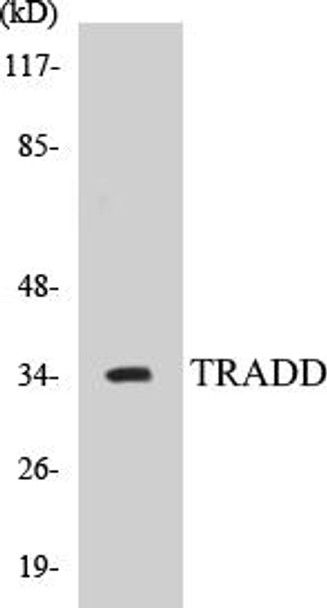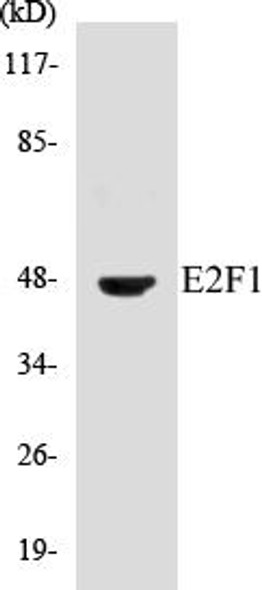Description
TRADD Colorimetric Cell-Based ELISA Kit
The TRADD Colorimetric Cell-Based ELISA Kit is a cutting-edge tool designed for the precise measurement of tumor necrosis factor receptor-associated death domain (TRADD) protein levels in cell lysates, tissue homogenates, and cell culture supernatants. With its advanced technology, this kit ensures high sensitivity and specificity, providing accurate and consistent results for a variety of research applications.TRADD is a key signaling molecule involved in regulating cell death and survival pathways, making it a crucial target for studying diseases such as cancer, inflammation, and autoimmune disorders.
By detecting and quantifying TRADD levels, researchers can gain valuable insights into the molecular mechanisms underlying these conditions and identify potential therapeutic targets.Whether investigating signaling pathways, assessing drug efficacy, or exploring disease mechanisms, the TRADD Colorimetric Cell-Based ELISA Kit offers a reliable and efficient solution for researchers seeking to advance their understanding of TRADD biology and its implications in various pathological processes.
| Product Name: | TRADD Colorimetric Cell-Based ELISA Kit |
| Product Code: | CBCAB00133 |
| ELISA Type: | Cell-Based |
| Target: | TRADD |
| Reactivity: | Human, Mouse |
| Dynamic Range: | > 5000 Cells |
| Detection Method: | Colorimetric 450 nmStorage/Stability:4°C/6 Months |
| Format: | 96-Well Microplate |
The TRADD Colorimetric Cell-Based ELISA Kit is a convenient, lysate-free, high throughput and sensitive assay kit that can detect TRADD protein expression profile in cells. The kit can be used for measuring the relative amounts of TRADD in cultured cells as well as screening for the effects that various treatments, inhibitors (ie siRNA or chemicals), or activators have on TRADD.
Qualitative determination of TRADD concentration is achieved by an indirect ELISA format. In essence, TRADD is captured by TRADD-specific primary antibodies while the HRP-conjugated secondary antibodies bind the Fc region of the primary antibody. Through this binding, the HRP enzyme conjugated to the secondary antibody can catalyze a colorimetric reaction upon substrate addition. Due to the qualitative nature of the Cell-Based ELISA, multiple normalization methods are needed:
| 1. | A monoclonal antibody specific for human GAPDH is included to serve as an internal positive control in normalizing the target absorbance values. |
| 2. | Following the colorimetric measurement of HRP activity via substrate addition, the Crystal Violet whole-cell staining method may be used to determine cell density. After staining, the results can be analysed by normalizing the absorbance values to cell amounts, by which the plating difference can be adjusted. |
| Database Information: | Gene ID: 8717, UniProt ID: Q15628, OMIM: 603500, Unigene: Hs.460996 |
| Gene Symbol: | TRADD |
| Sub Type: | None |
| UniProt Protein Function: | TRADD: Adapter molecule for TNFRSF1A/TNFR1 that specifically associates with the cytoplasmic domain of activated TNFRSF1A/TNFR1 mediating its interaction with FADD. Overexpression of TRADD leads to two major TNF-induced responses, apoptosis and activation of NF-kappa-B. Heterodimer with TNFRSF1A/TNFR1. Interacts with DAB2IP, FADD, HIPK2, KRT14, KRT16, KRT17, KRT18, RIPK1, SQSTM1, TRAF1, TRAF2 and TRPC4AP. Found in all examined tissues. |
| UniProt Protein Details: | Protein type:Apoptosis; Adaptor/scaffold Chromosomal Location of Human Ortholog: 16q22 Cellular Component: cytoskeleton; cytoplasm; nucleus; cytosol; receptor complex; lipid raft Molecular Function:identical protein binding; protein binding; signal transducer activity; protein complex binding; kinase binding; tumor necrosis factor receptor binding; molecular adaptor activity Biological Process: positive regulation of hair follicle development; caspase activation; positive regulation of I-kappaB kinase/NF-kappaB cascade; tumor necrosis factor-mediated signaling pathway; induction of apoptosis via death domain receptors; apoptosis; protein heterooligomerization; positive regulation of apoptosis; signal transduction; activation of NF-kappaB transcription factor |
| NCBI Summary: | The protein encoded by this gene is a death domain containing adaptor molecule that interacts with TNFRSF1A/TNFR1 and mediates programmed cell death signaling and NF-kappaB activation. This protein binds adaptor protein TRAF2, reduces the recruitment of inhibitor-of-apoptosis proteins (IAPs) by TRAF2, and thus suppresses TRAF2 mediated apoptosis. This protein can also interact with receptor TNFRSF6/FAS and adaptor protein FADD/MORT1, and is involved in the Fas-induced cell death pathway. [provided by RefSeq, Jul 2008] |
| UniProt Code: | Q15628 |
| NCBI GenInfo Identifier: | 6094511 |
| NCBI Gene ID: | 8717 |
| NCBI Accession: | Q15628.2 |
| UniProt Secondary Accession: | Q15628,Q52NZ1, B2RDS3, B3KQZ9, |
| UniProt Related Accession: | Q15628 |
| Molecular Weight: | 312 |
| NCBI Full Name: | Tumor necrosis factor receptor type 1-associated DEATH domain protein |
| NCBI Synonym Full Names: | TNFRSF1A-associated via death domain |
| NCBI Official Symbol: | TRADD |
| NCBI Official Synonym Symbols: | Hs.89862 |
| NCBI Protein Information: | tumor necrosis factor receptor type 1-associated DEATH domain protein; TNFR1-associated death domain protein; tumor necrosis factor receptor-1-associated protein; tumor necrosis factor receptor type 1 associated death domain protein |
| UniProt Protein Name: | Tumor necrosis factor receptor type 1-associated DEATH domain protein |
| UniProt Synonym Protein Names: | TNFRSF1A-associated via death domain |
| Protein Family: | Tumor necrosis factor receptor type 1-associated DEATH domain protein |
| UniProt Gene Name: | TRADD |
| UniProt Entry Name: | TRADD_HUMAN |
| Component | Quantity |
| 96-Well Cell Culture Clear-Bottom Microplate | 2 plates |
| 10X TBS | 24 mL |
| Quenching Buffer | 24 mL |
| Blocking Buffer | 50 mL |
| 15X Wash Buffer | 50 mL |
| Primary Antibody Diluent | 12 mL |
| 100x Anti-Phospho Target Antibody | 60 µL |
| 100x Anti-Target Antibody | 60 µL |
| Anti-GAPDH Antibody | 60 µL |
| HRP-Conjugated Anti-Rabbit IgG Antibody | 12 mL |
| HRP-Conjugated Anti-Mouse IgG Antibody | 12 mL |
| SDS Solution | 12 mL |
| Stop Solution | 24 mL |
| Ready-to-Use Substrate | 12 mL |
| Crystal Violet Solution | 12 mL |
| Adhesive Plate Seals | 2 seals |
The following materials and/or equipment are NOT provided in this kit but are necessary to successfully conduct the experiment:
- Microplate reader able to measure absorbance at 450 nm and/or 595 nm for Crystal Violet Cell Staining (Optional)
- Micropipettes with capability of measuring volumes ranging from 1 µL to 1 ml
- 37% formaldehyde (Sigma Cat# F-8775) or formaldehyde from other sources
- Squirt bottle, manifold dispenser, multichannel pipette reservoir or automated microplate washer
- Graph paper or computer software capable of generating or displaying logarithmic functions
- Absorbent papers or vacuum aspirator
- Test tubes or microfuge tubes capable of storing ≥1 ml
- Poly-L-Lysine (Sigma Cat# P4832 for suspension cells)
- Orbital shaker (optional)
- Deionized or sterile water
*Note: Protocols are specific to each batch/lot. For the correct instructions please follow the protocol included in your kit.
| Step | Procedure |
| 1. | Seed 200 µL of 20,000 adherent cells in culture medium in each well of a 96-well plate. The plates included in the kit are sterile and treated for cell culture. For suspension cells and loosely attached cells, coat the plates with 100 µL of 10 µg/ml Poly-L-Lysine (not included) to each well of a 96-well plate for 30 minutes at 37°C prior to adding cells. |
| 2. | Incubate the cells for overnight at 37°C, 5% CO2. |
| 3. | Treat the cells as desired. |
| 4. | Remove the cell culture medium and rinse with 200 µL of 1x TBS, twice. |
| 5. | Fix the cells by incubating with 100 µL of Fixing Solution for 20 minutes at room temperature. The 4% formaldehyde is used for adherent cells and 8% formaldehyde is used for suspension cells and loosely attached cells. |
| 6. | Remove the Fixing Solution and wash the plate 3 times with 200 µL 1x Wash Buffer for five minutes each time with gentle shaking on the orbital shaker. The plate can be stored at 4°C for a week. |
| 7. | Add 100 µL of Quenching Buffer and incubate for 20 minutes at room temperature. |
| 8. | Wash the plate 3 times with 1x Wash Buffer for 5 minutes each time. |
| 9. | Add 200 µL of Blocking Buffer and incubate for 1 hour at room temperature. |
| 10. | Wash 3 times with 200 µL of 1x Wash Buffer for 5 minutes each time. |
| 11. | Add 50 µL of 1x primary antibodies (Anti-TRADD Antibody and/or Anti-GAPDH Antibody) to the corresponding wells, cover with Parafilm and incubate for 16 hours (overnight) at 4°C. If the target expression is known to be high, incubate for 2 hours at room temperature. |
| 12. | Wash 3 times with 200 µL of 1x Wash Buffer for 5 minutes each time. |
| 13. | Add 50 µL of 1x secondary antibodies (HRP-Conjugated AntiRabbit IgG Antibody or HRP-Conjugated Anti-Mouse IgG Antibody) to corresponding wells and incubate for 1.5 hours at room temperature. |
| 14. | Wash 3 times with 200 µL of 1x Wash Buffer for 5 minutes each time. |
| 15. | Add 50 µL of Ready-to-Use Substrate to each well and incubate for 30 minutes at room temperature in the dark. |
| 16. | Add 50 µL of Stop Solution to each well and read OD at 450 nm immediately using the microplate reader. |
(Additional Crystal Violet staining may be performed if desired – details of this may be found in the kit technical manual.)






